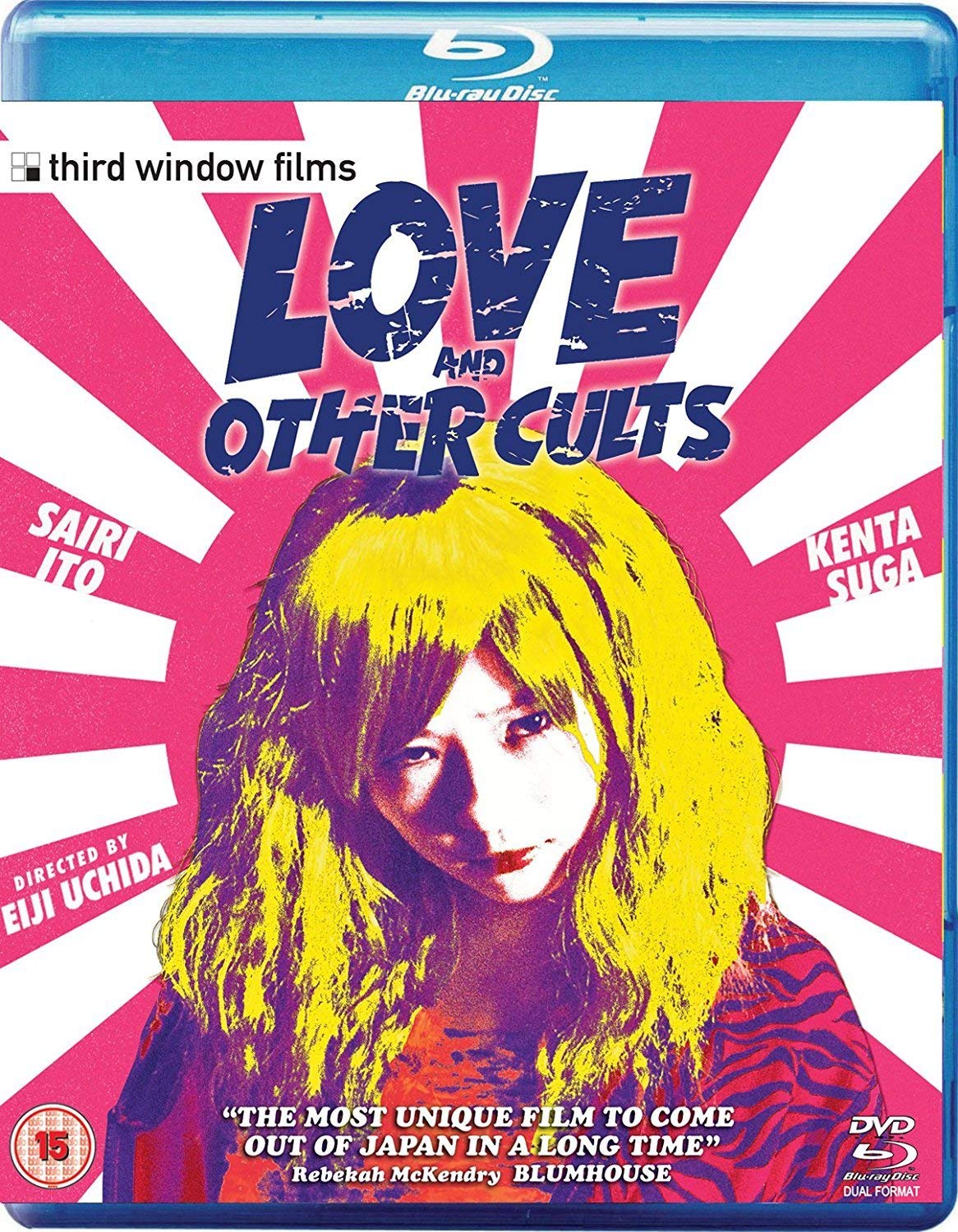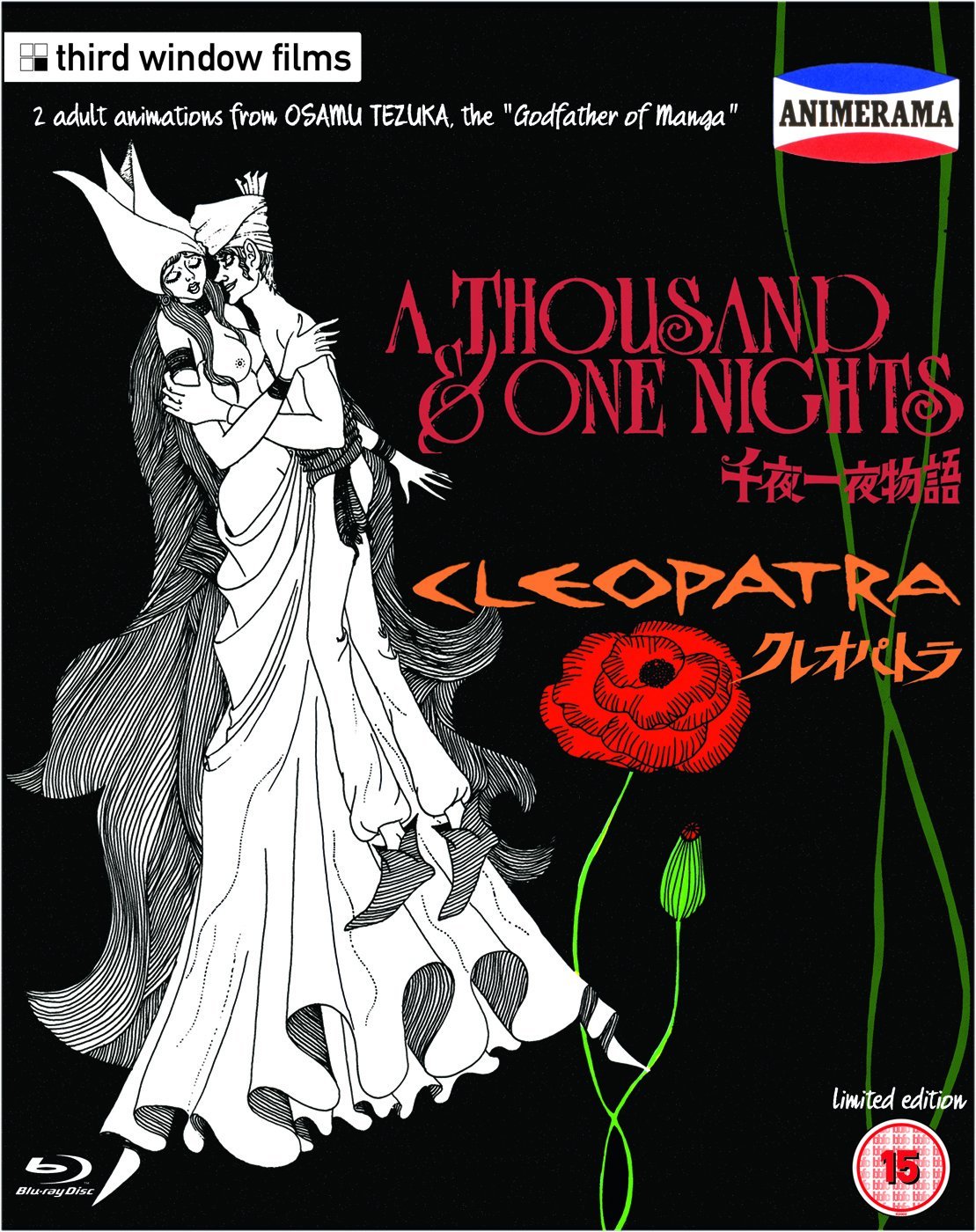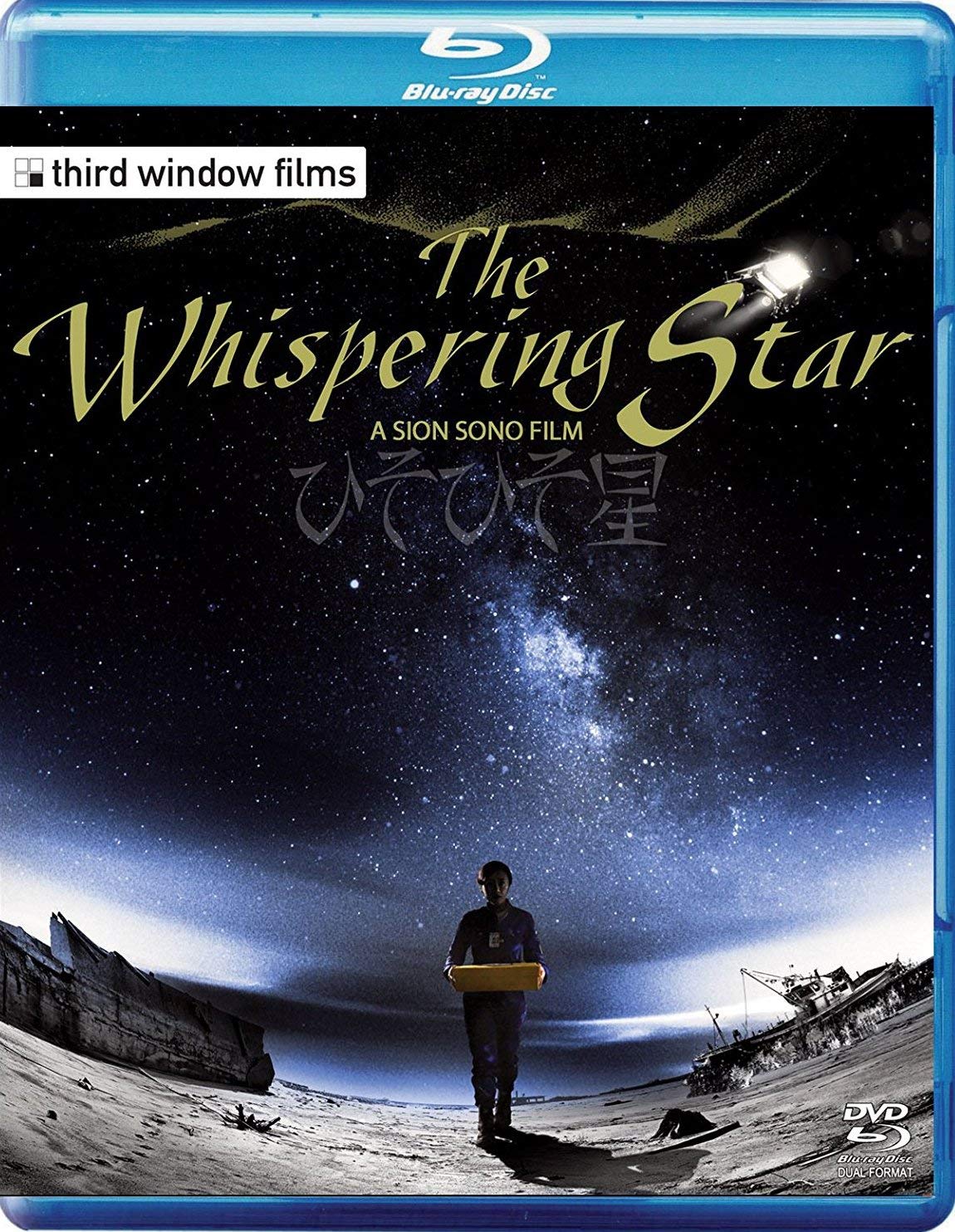Now on Blu-ray: LOVE AND OTHER CULTS, Animerama, ANTIPORNO, and THE WHISPERING STAR from Third Window
UK's Third Window Films have had a rough year, but they are coming back strong with a quartet of solid releases from some of Japan's most exciting filmmakers. Today we're looking at their recent Blu-ray releases of Uchida Eiji's Love and Other Cults, Yamamoto Eiichi and Tezuka Osamu's Animerama double feature of Cleopatra and A Thousand and One Nights, and a pair of Sono Sion films from the last couple of years, Antiporno and The Whispering Star. Learn more about these great releases below.
Ard Vijn, James Marsh and Todd Brown
contributed to this story.




One of the many new voices in Japanese cinema that Third Window has introduced to the west is Uchida Eiji. They previously released his amazing feature Greatful Dead on Blu-ray and went on to produce his film Lowlife Love not too long after. Most recently Third Window head honcho Adam Torel produced Uchida's Love and Other Cults, and it's just further proof that this is a filmmaker to look out for.
Love and Other Cults is a story that centers around a pair of lost losers looking for a true calling in life. Suga Kenta is Ryota, a low level yakuza thug who is enamored with the flighty Shima Ai, played by Itô Sairi. The film follows them as they each make a million mistakes on their way to finding their mission, most of which involve flitting between religions and cults or cults of personality before finally finding that what they need is each other, kind of.
Ard Vijn saw the film at last year's Camera Japan festival and had this to say:
Playing loose does allow Uchida to focus a lot on the side characters, and a good thing that is too as they often provide the best material in the film. I'd like to single out comedian Antony, who impresses as gang leader Kenta. Being black and heavy-set, Kenta starts of as a kind-of walking special effect, with all people just scared to death of him. But he soon starts on an interesting character arc of his own, and despite being a first-time actor Antony rises to the role as needed.
[...]
All in all, Love and Other Cults is hard to define. The terms "black comedy" and "drama" don't quite cut it, though there is plenty of both in it. In this it is quite like Uchida's earlier film Lowlife Love. Both films are interesting but do require an appetite for a certain weird flavor. Maybe Uchida Eiji is building his very own niche-genre?
I must say that I was far more enamored of the meandering nature of the film. It feels very much like Sono Sion's breakout feature Love Exposure in its focus on religious transience as a mode of self-discovery. Though I do agree with the spotlight on Antony, a half-black supporting character who seems to be the only person in the entire film with his shit together. It's a fun ride and an interesting look at various subcultures in urban Japan into which not many have insight.
The Disc
Love and Other Cults was shot digitally, so it looks and sounds great. No issues to report in terms of A/V
In terms of extras, Third Window have provided a lovely behind the scenes documentary on the making of the film and an interview between Uchida and his leading man, Suga Kenta. The interview, though it is shorter and more focused than the doc, is the more interesting piece to be because it exposes a unique dynamic between the director and his star, neither of whom really now much about the other. We get to watch each of them discover the other in more or less real time and that's the kind of unexpected thing I enjoy.
Love and Other Cults is definitely recommended.
A couple of years ago, the world was reintroduced to a long forgotten series of films from the godfather of manga, Tezuka Osamu, the Animerama films, via the release of The Belladonna of Sadness. These films were animated features designed for and marketed toward more adult audiences than the usual anime subjects, and that got them somewhat unfairly categorized as adult-only films, which subjugated them to an erotic film niche. While Animerama was certainly a more mature line and anime features, it's far from the hardcore adult content that would flood the market in the '80s, and so it's a blessing that these films are finally being rescued and given their fair due through releases from companies like Third Window Films.
While US distributor Cinlicious did a bang up job with Belladonna a couple of years ago, Third Window has picked up the other two films in this trilogy, A Thousand and One Nights and Cleopatra. Both films were directed by Yamamoto Eiichi, who also directed Belladonna of Sadness, while Cleopatra was co-directed by Tezuka, himself. These two films are more traditional animation thatn Belladonna, which used a more static method, however, they are no less adventurous than that feature.
A Thousand and One Nights tells the story of Aladin, or Aldin as this story calls him, and his journey from peasant to prince in the ancient Arab world. The film is filled with beautiful imagery and follows the traditional story well enough, leaving room for modern flourishes and a bit more sex and violence than perhaps existed in the original. It's a wonderfully ribald take on a classic tale that takes its subject just seriously enough to have the audience invested in the outcome, but not so seriously as to be above a good sight gag here and there - references to the '60s studio the Rank Organisation and a quick flash on the crumpled Tower of Babel being "Made in Japan" are just a couple of the broad jokes in the film. It's a fun film that, while it definitely doesn't shy away from animated boobs, is more a studies of man's foibles and faults than his lust.
Cleopatra is a much more unusual piece in that it starts as a science fiction feature in which a team of astronauts are sent back in time to infiltrate ancient Egypt to influence the dealings between Julius Caesar and Cleopatra, though this facade really only stands in the very beginning and at the very end of the film. In between these futuristic bookends we see Cleopatra, Caesar, Marc Antony, and all and sundry in between deal in sex and violence to ensure the continued existence of the Egyptian empire, with of course plenty of sex to steer the ship. Tezuka's humor once again makes an appearance as the film includes broad references to Frankenstein, and uses the artistic styles of masters from Klimt to Picasso to Degas to spice up the proceedings. It's another fun film, perhaps even more light-hearted than A Thousand and One Nights, and well worth checking out for fans of classic anime.
The Discs:
Third Window have wisely presented this pair of films on two separate Blu-rays and the results are pretty good. I hate to judge them against Belladonna of Sadness, which underwent a massive 4K restoration, but these two clearly didn't, and while an upgrade to Blu-ray is a godsend and definitely noticeable, it's not quite the revelation that the earlier release was. There is minor damage to the image here and there, but nothing terrible. Overall this is a solid release for each of these films and definitely worth a recommendation.
Each film comes with an audio commentary from author Helen McCarthy, who penned The Art of Osamu Tezuka: The God of Manga, and these commentaries are packed with invaluable tidbits for inquisitive viewers. McCarthy explores not only the films themselves, but also their influences via Tezuka's youth idols and the artists who made the biggest impact on him. In addition to this there is an interview with Yamamoto Eiichi on the disc for A Thousand and One Nights in which he describes his career leading up to and including the production of these films. It's a great interview that shines a light on a pioneer who still doesn't seem to get the credit he deserves.
This double feature is a unique artifact that is required viewing for anyone interested in the roots of anime or even simply Japanese films from the late '60s - early '70s. A Thousand and One Nights and Cleopatra come highly recommended.
One of the most unique commercial cinema experiments of the 20th century was Nikkatsu's Roman Porno series of erotic films. Roman Porno, which was short for "romantic pornography", was a series of films from the early '70s through the '80s that were produced with the hope that they'd be able to recapture the theatrical movie going audience who'd been largely consumed by TV and home video. The hope was that by providing something that couldn't be shown on television, more explicit sex and violence, that these films would reinvigorate a flagging cinema industry. And it worked, for a time. By the late '80s - early '90s DTV boom in Japan, Roman Porno began to seem quaint and the brand died out, but it left behind a ton of ardent fans desperate for the trend to continue.
By the late '90s - early 2000's, it was clear that the internet could show you anything you wanted to see, but there was still a lack of quality filmmaking and a couple of years ago Nikkatsu decided it was time to take a chance on Roman Porno again, so began the Roman Porno Reboot series of films. Produced by Nikkatsu, the idea was to give talented filmmakers a modest budget and put upon them the same constraints that guided the original boom, a sex scene every 15 minutes or so, and as much violence as one could stomach. Among the initial crop of filmmakers invited to take up the challenge was Sono Sion (Love Exposure, Love & Peace, etc), and what he came up with was Antiporno, a film that manages to meet all of these criteria while still managing to skewer the very impulses that make it desirable.
James Marsh named the film as one of his favorites of 2017 and had this to say:
After a string of misguided attempts to address feminism and the role of women in Japanese society, Sono comes close to making a point in this ambitious, visually ravishing and surprisingly intelligent entry in Nikkatsu’s roman porno reboot project. Ami Tomite plays a spoilt prima donna wrestling with nausea and self-doubt in a luridly fluorescent gilded cage. All is not what it seems however, and Sono broaches a number of topics relating to the Japanese cinema and his own role in the objectification of women.
Antiporno is a bit of a redemption for Sono, whose works often vacillates between misanthropic and misogynist. This film shows him to be not only self-aware, but perhaps even a but contrite about his own complicity. He spares none of the exploitative elements, but at the same time renders the film largely sexually inert, instead drawing attention to the manipulations of sexploitation in a way that is unique and engaging while remaining narratively obtuse. I really enjoyed this film and can't wait to see more from both the series and Sono.
The Disc:
Antiporno was shot digitally, it looks and sounds fantastic. Next.
Third Window have provided a behind-the-scenes featurette that shows a lot of what went into Antiporno and shows just what a challenging shoot it must've been. It's a great doc and well-received because the film itself is so artfully composed and art directed that it definitely deserves the attention. There's also a 20+ minute interview with star Ami Tomite, who is eager to talk about her work in the film and her career with Sono, and a brilliant audio commentary from Jasper Sharp, author of Behind the Pink Curtain, the definitive English language work on the Pink (erotic) films of Japan.
Antiporno is another home run for Third Window Films and a disc that any Sono fan should have in their collection.
The final disc in this round up is a double feature of Sono Sion's The Whispering Star and a 2016 documentary by Oshima Arata focusing on the director titled The Sion Sono. While the latter isn't specifically about the former, the filming of the documentary took place largely around the shoot for The Whispering Star, making this an ideal pairing.
In The Whispering Star, Sono mainstay (and wife) Kagurazaka Megumi (Cold Fish, Why Don't You Play in Hell?) plays an android delivery woman slowly making her way from one end of the galaxy to the other delivering packages of some import to seemingly random folks. The film was mostly shot against the desolate and deserted backdrop of post-3/11 tsunami Fukushima, lending it an otherworldly texture and adding to the film's robotic ennui. Our fearless leader Todd Brown reviewed the film out of TIFF 2015:
A minimalist black and white affair, The Whispering Star is a long gestating passion project of its creator - one of his earliest scripts now dusted off and brought to fruition because the lingering devastation of the Fukushima region both provides the director the chance to shoot a post apocalyptic landscape on the cheap while also providing the perfect thematic backdrop for this wistful fable of humanity undone by its own carelessness.
One might describe The Whispering Star as deliberately paced - or simply as very, very slow - but the pacing is leavened to a great degree by a quiet sense of humor and playfully anachronistic set design which may very well be a deliberate nod to the work of Cory McAbee (The American Astronaut, Stingray Sam). Despite the very limited scale of the set Sono keeps things visually engaging with his creative camera work and gorgeous black and white cinematography.
Given that even the biggest, most commercial points of Sono's career are firmly niche items everywhere outside of Japan it is very likely that this, a willfully non-commercial film, will never be available anywhere in the world outside of festival appearances where the audience will be fueled by the existing Sono faithful. But for those who are already in the Sono club this is a worthy curio to seek out.
Everything Todd says is true, though your mileage may vary with this one. Even as a largely loyal fan of Sono's, I found myself tuning out pretty frequently during The Whispering Star. I hate to use the phrase tone poem - and I'll likely self-flagellate later to atone - but it seems as appropriate here as it will likely ever be. The film is slow, to put it mildly, and why minimal dialogue there is is delivered in whispers, which irritated me more than a little. If you're looking for Why Don't You Play in Hell or Tokyo Tribe, I might advise you to keep right on walking when it comes to The Whispering Star. It was not my thing.
The Disc:
Even though the disc is labeled a double bill of the above mentioned feature and The Sion Sono, the documentary is included as a bonus feature, so I will discuss it as such. The Sion Sono is far more engaging than the main feature on this disc. Director Oshima Arata talks at length with Sono and his with Kagurazaka and other collaborators about his early life and career, his current career path, his influences, his attitude toward art, and even gives us precious glances into his earliest attempts at filmmaking. Sono is a filmmaker with over forty features under his belt, only a handful of which have made it to the west in any way, and The Sion Sono will definitely make fans even more curious about the missing pieces.

More about Love and Other Cults
More about Cleopatra (Animerama)
More about Antiporno
More about The Whispering Star
- Exclusive: Sono! Sabu! Uchida! Animerama! Third Window Films 2018 Slate Looks Amazing!
- Japan Cuts 2016 Turns 10, With Major Stars, Parties, Lots Of Sono Sion, An Android Actor, And More
- Toronto 2015 Review: Sono's WHISPERING STAR Is A Hushed-Tone Oddity, Even By Sono's Standards
- Toronto 2015: Check Out The Teaser For Sono's THE WHISPERING STAR
- Toronto 2015 Preview: TIFF Docs & Contemporary World Cinema
Around the Internet
Recent Posts
Rotterdam 2025 Interview: Toshiaki Toyoda
THE COPENHAGEN TEST Review: Under Surveillance
Leading Voices in Global Cinema
- Peter Martin, Dallas, Texas
- Managing Editor
- Andrew Mack, Toronto, Canada
- Editor, News
- Ard Vijn, Rotterdam, The Netherlands
- Editor, Europe
- Benjamin Umstead, Los Angeles, California
- Editor, U.S.
- J Hurtado, Dallas, Texas
- Editor, U.S.
- James Marsh, Hong Kong, China
- Editor, Asia
- Michele "Izzy" Galgana, New England
- Editor, U.S.
- Ryland Aldrich, Los Angeles, California
- Editor, Festivals
- Shelagh Rowan-Legg
- Editor, Canada










